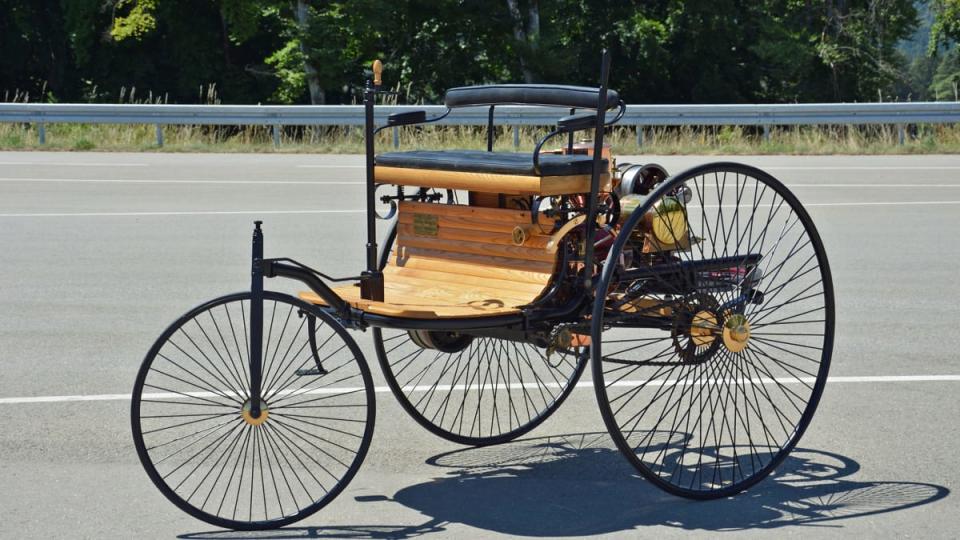Drive like it’s 1885: What it’s like to take the tiller of the first car, a Benz Patent-Motorwagen

IMMENDINGEN, Germany — Set your time machine to August 1888. It's hot, humid, and you're in a small German town enjoying a refreshing pint of hefeweizen when an unusual noise breaks the silence. It almost sounds like a train, but it can't be — there are no tracks for a train to travel on. The source of the cacophony appears halfway through your next sip: It's carriage-like, yet there's no horse pulling it and it's eerily moving under its own power.
Back to the present (you can bring the hefeweizen with you). It's hot, humid, and you're relaxing in a small German town. Suddenly you hear a car coming — who cares? Unless it's something really special, like a Glas 1300 GT, odds are you wouldn't pay attention to it. However, in 1888 you would have witnessed what's widely recognized as the first car take its first road trip with its inventor's wife at the ... well, not really at the wheel, because the steering wheel hadn't been invented yet, but at the little metal tiller used to turn the lone, bicycle-like front wheel.
Carl Benz built the Patent-Motorwagen in 1885 and received a patent for his invention, which he described as a "vehicle with gas engine operation," on January 29 of the following year. He essentially invented the car. Sure, someone else might have designed a vehicle with gas engine operation in 1882, and it may have worked wonderfully, but there's no trace of it. Benz applied for and received the patent for the car, and his wife, Bertha, embarked on the first road trip — a 112-mile trek from Mannheim to Pforzheim and back — with her kids two years after that.
Now it's my turn to take the Patent-Motorwagen for a spin over 130 years later at the Mercedes-Benz test track in Immendingen, Germany.
Smart but simple
One point worth clarifying is that this isn't the first car. It's one of the replicas built by Mercedes-Benz in the 2000s, so it's an exact copy of the original. It starts, accelerates, and brakes just like the real thing, and I'm told that the dimensions and the mechanical layout are identical. Carl Benz restored the original Patent-Motorwagen in 1906 and donated it to the Deutsche Museum in Munich. It's still there today.
At first glance, there wasn't much going on in the design department (in that there literally wasn't one). From every angle the Patent-Motorwagen resembles an old car, one that perfectly embodies the "form follows function" philosophy. And yet, it's a fascinating object to look at. It's motorcycle-like in its simplicity and openness. There's no body, it's pretty much an engine and a bench-like seat dropped on a steel frame, so the mechanical components are clearly visible. That's its beauty: It's a mechanical type of seduction that began vanishing from the automotive industry many decades ago.
There's not much of an interior, either. Before you sit in (on?) the Patent-Motorwagen, let alone take it for a spin, it's interesting to notice how little it shares with the commonly accepted definition of a modern car. If it rains, you're wet. If you've got a suitcase to take with you, tough luck. If you want to know how fast you're going, take a guess. Relax: It's not like there were speed limits to respect in those days. The only comfort-related equipment is a bench seat with padded armrests, a short padded backrest, and springs to keep your spine in one piece.
Even if speed limits were strictly enforced, speeding is the least of your worries in the Patent-Motorwagen. Power comes from a single-cylinder, 1.0-liter engine that develops about 0.75 horsepower at around 400 rpm and unlocks a top speed of roughly 10 mph. You'd have gone faster on a horse, though a slower trip was a fair tradeoff for not traveling accompanied by the smell of manure. Mounted horizontally over the rear axle, the engine spins the rear wheels via a differential, a leather belt, and a series of metal chains. It runs on petroleum-based ligroin instead of gasoline, and it features an open cooling system without a water pump, an open crankcase and a massive flywheel.



 Yahoo Autos
Yahoo Autos 
